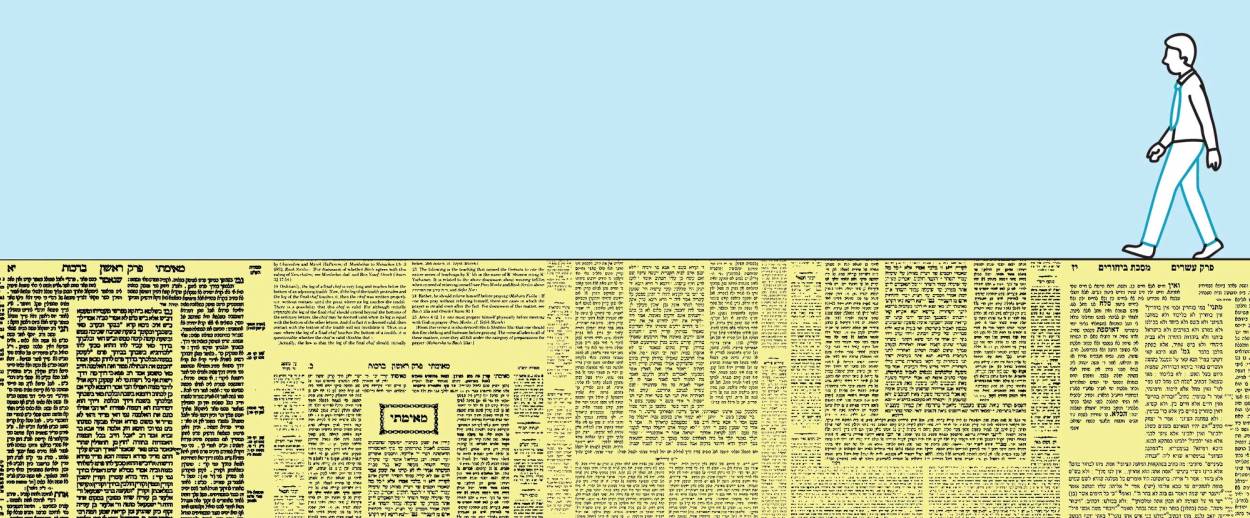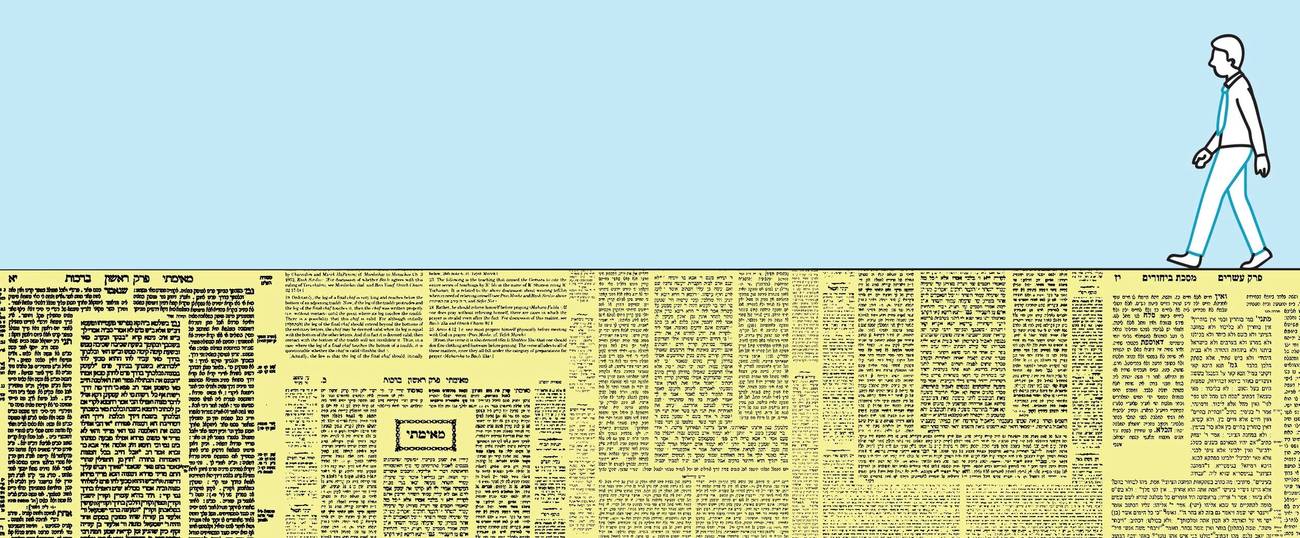One Page at a Time
What one Reform rabbi learned from completing the seven-and-a-half year cycle of ‘Daf Yomi’ Talmud study




I was the only one in the pediatrician’s waiting room with Tractate Yoma in one hand and my kid’s winter hat in the other. This was reminiscent of being the only one at my airport gate with Tractate Yevamot in one hand and a veggie burrito in the other. And that was reminiscent of stuffing Tractate Bava Batra next to Frisbees and Snapples in my beach bag when my family and I made our way to the Jersey shore for an afternoon.
When you study Talmud every single day for seven-and-a-half years, the pages become a part of you. You are holding a tractate so often it becomes an appendage. It also means studying on the day of your kids’ birthday parties, while away in the Caribbean with your wife, and late at night because you got caught up in Monday Night Football. I studied on the day I turned 40. I studied on my 15th wedding anniversary. I studied the day my grandmother died. I studied on Yom Kippur, Hanukkah, and Purim. I studied on Halloween, Thanksgiving, and the Fourth of July.
Along with tens of thousands of people the world over, I have just completed reading all 63 volumes of the Babylonian Talmud—all 6,200 pages, more than a million words of Hebrew and Aramaic written more than a millennium ago.
Daf Yomi was perhaps one of the most trying endeavors I could have drawn up for myself. While at times it challenged my sense of belief, having me reconsider my own understanding of God and Israel and prayer, more than anything it challenged my ability to study for at least 15 minutes every day no matter what the day brought: illness, emergencies in my congregation, funerals that necessitated hours of driving, snow days, and the ever-present voice that had had enough of such a project.
It’s not the kind of thing most Reform rabbis are expected to do—either by their congregants, or by other, more typically Orthodox students of the Talmud. Indeed I was an outlier, a fact I learned to embrace.
*
The idea was first proposed to me by a colleague. He and I had studied a significant amount of Talmud in rabbinical school and he knew I had written my rabbinic thesis on a series of connected talmudic legends. He felt it was the next logical step for us, especially as we both approached a point in our rabbinate where we were feeling more settled and at-home with the demands and unique challenges of rabbinic life. I wasn’t sure it was so logical but agreed to do it nonetheless, drawn more than anything to the sheer size and grandeur of it. Could I do this? Where would the process take me? Would I let it change me?
My friend and colleague hung on for a while but eventually bowed out, so I studied for the most part by myself. It was often my only solitary time all day, given a crowded house with three highly energetic kids and a bustling congregation of some 400 families. More often than not I would study at my desk at the synagogue, before tackling a day’s worth of emails and meetings, hospital visits, and life cycle events. Like so much else in life, it became second nature simply because I refused to quit. By the time I was six months in, it seemed foolish to stop. I came back to that sentiment often over the first few years. I’d think about stopping but had come too far. How could I give up now? I couldn’t.
It’s also the very layout of the Babylonian Talmud that drew me in. As Rabbi Mira Wasserman has noted, the Talmud reads less like a typical rabbinic text and more like a novel. I found the end of each tractate particularly enthralling, and thus was propelled to the start of the next, as if actually pushed there by the likes of Akiva and Hillel. Consider the end of Tractate Sotah, for instance, which has the text recount the many iconic values that died as each sage who embodied that value died. With boldness it declares that when Yohanan ben Zakkai died so did wisdom. When Abba Yosei died so did piety. When Yehuda HaNasi died, humility itself died. At the final line of the 49-page tractate, Rav Nahman speaks up, a still, small voice of hopefulness: “Do not fear that fear of sin died, for there is still one that fears sin: Me.”
It is this kind of moment that defies all expectations and assumptions regarding Talmud study. At least it did for me. For those that want to believe that it’s a cold text of yesteryear, such moments prove endlessly heartwarming and uplifting, claiming with chutzpah that we mortals of today have as much to offer the Jewish world as the great names that preceded us.
I was surprised all the time while engaging in Daf Yomi. As a Reform rabbi, I was in a decidedly small group of progressive Jews who had taken on the project. But I saw once and again that the Talmud is as progressive as any document we Jews lay claim to, with endless references to change, and how to make Judaism work in whatever age the reader found him/herself. I was often stunned by the myriad ways the rabbis interpreted and reinterpreted hardened stances on issues like kashrut, abiding by an eruv, and even making time for study—all areas in which I only assumed steadfastness. Instead they spoke of flexibility (of course a woman in labor can eat treyf!), and the importance of doing the mitzvah at all as often more pressing than how or when. Such revelations gave me license to go further in my own practice, rethinking Shabbat and learning and holiday observance in my own life and the life of my congregants.
As my enthusiasm for Talmud study grew, so did my enthusiasm for teaching Talmud. My monthly Talmud classes grew in number over the years, maybe because of my consistently raised eagerness. I was bringing them texts well beyond the obvious, overanalyzed talmudic stories so many have come to love: The Oven of Akhnai, Kamza and Bar Kamza, Akiva coming to study late in his life, the harrowing story of Yehuda HaNasi’s death. I brought them little-known nuggets from Menahot and Moed Katan, and other less likely tractates, and we loved them together.
*
The most uplifting part of my Daf Yomi experience came when I had cancer. In year three of my journey I was diagnosed with non-Hodgkin’s lymphoma. This resulted in a month in the hospital to receive a most aggressive form of chemotherapy, followed by 17 rounds of radiation. It might have marked the end of Daf Yomi for me but actually the opposite is true. Through all of it I studied and with great devotion, even with nurses scrambling around me and my vitals being taken multiple times every hour. During those months the sages’ words were less for my mind and more for my heart. They reminded me that I was alive and that I was still part of this sacred community, even while cloistered in the oncology wing at the Hospital of the University of Pennsylvania.
I also found that Daf Yomi gave me entrance into worlds I had never known. Quoting Sanhedrin 97 and its discussion of what will bring the Messiah caught the attention of Orthodox colleagues at our communal rabbis’ meetings. Asking a Chabad rabbi what he thought of Makkot 24 as it unpacks Psalm 15 brought our friendship to a new level. Including talmudic wisdom in opinion pieces garnered the attention of those who might not have otherwise considered the musings of a proud Reform Jew. Standing in line at the Franklin Institute I joked to an Orthodox rabbi in front of me that we could’ve finished Bava Batra before our turn came up. We were bonded instantly. I was not only studying the words but incorporating them into my daily life, my vocabulary, my sense of self.
While all of this might sound poetic, even inspiring, much of Daf Yomi is not at all poetic. Pages upon pages devoted to the ancient practice of levirate marriage or entire volumes devoted to the minutiae around animal sacrifices we haven’t done for over 1,500 years. Zevahim was tough. Bekhorot was tougher. These sections of the Talmud begged me to quit but I never relented. I knew that if I could press on there would be talmudic gold waiting for me buried somewhere in the tractate and there always was.
As we reach the end of this cycle, vast crowds of black-hatted Orthodox men will gather this week in places like MetLife Stadium outside New York City to toast one another and celebrate the accomplishment of coming at last to the end. It is not lost on them, or me, that completion requires persistence, relative health, and even a bit of luck. Such mass gatherings will happen virtually everywhere Jews live.
As for me, I’ll celebrate quietly. I am working to convene a panel at the Reform seminary, Hebrew Union College-Jewish Institute of Religion, alongside professor Alyssa Gray, which will have us discuss the place of Talmud in Reform Jewish life today. We’ll discuss with students ways to bring study into their daily life in a meaningful way as well as how Talmud might inform not only their own work, but their personal practice.
Then I’ll go home and, naturally, begin again.
***
Like this article? Sign up for our Daily Digest to get Tablet magazine’s new content in your inbox each morning.